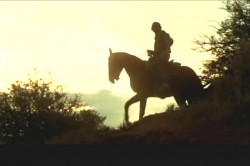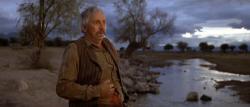Reviews
Sydney Pollack
USA, 1972
Credits
Review by Steve Macfarlane
Posted on 16 April 2013
Source Warner Home Video DVD
Categories Acid Westerns
The rewritten, Italian-release title of Jeremiah Johnson - Red Crow You Will Not Have My Scalp - says more about what Sydney Pollack’s 1972 revisionist-naturalist Western isn’t than what it is. At this time Robert Redford’s uneasy relationship with his stud reputation was blossoming into full-on activist mode, and no director enabled the restructuring of the Redford brand from twinkle-eyed poster boy into wounded, earthy radical better than Pollack. Only Michael Ritchie’s The Candidate interrogated Redford, as a more-than-plausible empty suit who only begins to develop an authentic political consciousness after he’s been transformed into a billboard already. Pollack’s collaborations with the star - especially Jeremiah Johnson and Three Days of the Condor - sped viewer and hero alike through ideological conundrums that would add up to a richer understanding of the complexities of American history and its attendant guilt, but not without a fair amount of entitled fist-shaking when all was said and done.
Intriguingly, Jeremiah Johnson turns the aforementioned redemption saga on its ear, tracing Johnson’s evolution from this film mountain man to Indian-integrated peacenik back to bloodthirsty trapper, leaving him with more questions than answers. Johnson is a tight-lipped deserter from the Mexican War, fed up with humanity, looking to eke out a solitary life for himself in the Colorado Rockies, painted in the folksy naturalism of many a mood music album cover from the period. Redford apparently convinced Pollack to shoot on location in Utah, and the struggle between letting the canned dramaturgy influence the locations and not vice versa is palpable throughout the film. The film’s sparse gruffs of dialogue overflow with subtext, as does the opening number by Tim McIntire, who sweetly lilts that “a story doesn’t always go / the way you had in mind / Jeremiah’s story was that kind.”
After a silent staredown with the Crow chief Paints-His-Shirt-Red, Johnson is found by a colorful crank named “Bear Claw” Lapp who, in a bit of foreshadowing, lives as though he were a Blackfoot himself, and initiates Johnson’s long, tortuous education in the ways of the mountain man. Calling him “pilgrim”, Lapp scolds Johnson for longing after female company; he insists that “a woman’s breast is the hardest rock the Almighty ever made on this earth.” But lest viewers begin to despair that they’ll never see Redford shirtless again, he comes across a cabin that’s been marauded by Blackfeet—including a mute young boy and his raving mad mother, the only survivors. Johnson adopts the boy; the mother dissolves, like many characters, into the landscape that surrounds Johnson but never touches him again.
Whether this episodic blurring of narrative and symbolic strokes was intentional on the part of Pollack, or just badly scripted (by John Milius and Edward Anhalt) is hard to figure, but it’s an interesting feature, and a bellwether of the film’s ambitions to be a proper Western without a sustained narrative arc. Johnson and the boy meet another gregarious trapper named Gue, whose feelings about Indians aren’t anywhere near as genteel as Lapp’s. The two fight off a Blackfoot ambush, and Pollack tries his hand at editing for action—often re-choreographing the same tumbles, kicks, punches and gunfire for different angles and then cutting aggressively between them, as close a response in montage to Peckinpah’s so-dubbed “balletic” emphasis on juxtaposing slow and regular-speed as is visible in studio-made revisionist Westerns. (Johnson, as it turns out, is really good at killing Indians, but disgusted at the prospect of scalping or graverobbing.)
Gue, Johnson, and the boy are intercepted by a different tribe—this time, God-fearing Flatheads who hate the Blackfeet almost as much as Gue does. Johnson nobly attempts to turn the page by offering them the scalps and horses from the prior battle, but offends the chief into one-upping his generosity with a gift of his own: his comely daughter Swan. And so Johnson, the mute boy and Swan set out to live, again, peacefully, making a log cabin from scratch, pelting bears to keep warm. These domestic scenes comprise the film’s midsection, and their politics - if unintended - are awfully creaky. Once Swan and Johnson start actually having sex, he realizes his beard has been scratching her face; the quivering wind section that greets Redford, shaven, seems designed to signal a turning point in their understanding of each other.
A Cavalry shows up near Johnson’s home in search of an abandoned missionary wagon, he advises them against passing through a sacred Crow burial ground. They do anyway, and Johnson returns from a hunting trip to find both Swan and the mute boy killed. So it goes: suffering on account of his attempt to work with his surroundings rather than against them, Johnson treks out in solitude again, regrowing his beard—and of course, killing more Indians. Whenever Redford and the natives engage in battle, the blocking and rhythm of the scenes takes on an almost feral quality, with the director so emphatic on pushing their brutality that they become more brutal but less realistic. During quiet moments, Johnson stares into the distance with a hard glint in his eye, statuesque.
Pollack’s design is logjammed between the relatively humorless widescreen technicolor panoramas of yesteryear and the soft-focus telephoto explorations of the time. Whereas Robert Altman and Vilmos Zsigmond managed, in McCabe & Mrs. Miller, to enshroud their characters among blankets of snow and pine trees as optical vespers, uneasy blots moving across landscapes, Pollack and his cinematographer tend to stick with regular wide and medium shots - especially for dialogue scenes - with giant mountain-sides shoved in the background. That’s Jeremiah Johnson to a T: sandwiched between mood and character with no real definitive linkage of either, an oddly straight-laced attempt to conjure a miracle from prime ingredients with plenty of care, but no real thought, to their arrangement. The intent seems to be: Robert Redford plus beard plus fiddle music plus pine trees equals Thoreau. Redford reportedly was a pallbearer at the 1972 reburial of the real Johnson (a man named John Johnston) in Cody, Wyoming; it is an especially messianic type of Hollywood film that allows its leading man to be both hero and victim.
More Acid Westerns
-

Ride in the Whirlwind
1965 -

The Shooting
1966 -

El Topo
1970 -

The Hired Hand
1971 -

The Last Movie
1971 -

Greaser’s Palace
1972 -

Bad Company
1972 -

Ulzana’s Raid
1972 -

Jeremiah Johnson
1972 -

Pat Garrett & Billy the Kid
1973 -

Kid Blue
1973 -

Dead Man
1995
We don’t do comments anymore, but you may contact us here or find us on Twitter or Facebook.



